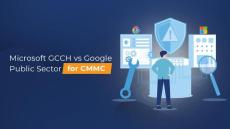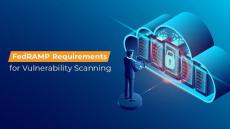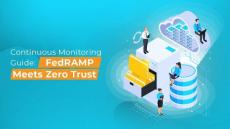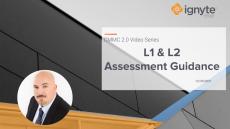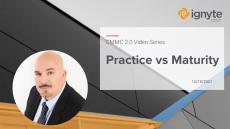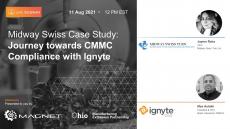|
By Max Aulakh
When it comes to overall productivity platforms, collaboration tools, and office suites, the two biggest options dominating the market are the Google G Suite and Microsoft’s Office ecosystem. Whether it’s word processing, team collaboration, IT frameworks, device management, or the entire infrastructure of a business, there’s a pretty good chance one of these two options is going to power the way you operate.
|
By Max Aulakh
A lot goes into protecting the information security of the nation. The National Institute of Standards and Technology, NIST, maintains a list of security controls under the banner of NIST SP 800-53, Security and Privacy Controls for Information Systems and Organizations. Meanwhile, the Federal Risk and Authorization Management Program, or FedRAMP, sets up a framework that makes those security controls apply to governmental agencies and the third-party cloud service providers that work with them.
|
By Max Aulakh
FedRAMP is a key part of maintaining the digital security of the federal government, by way of enforcing security rules across departments and the cloud service providers that work with them. Any CSP that wishes to work with a federal agency or department and handle controlled information needs to obtain an authority to operate (ATO) from the program management office. Part of that ATO is the continuous monitoring of the CSP’s systems to ensure ongoing security in a changing world.
|
By Max Aulakh
Security isn’t something you implement once and leave alone. It’s a mindset, an operation, and an ongoing policy. Security frameworks like FedRAMP require a process called continuous monitoring in order to remain valid. The world of information threats is constantly evolving. Technology grows, changes, and improves, but with those changes come new vectors for intrusion, new methods for unauthorized access, and new exploits.
|
By Max Aulakh
The full compliance process for CMMC, the Cybersecurity Maturity Model Certification, culminates in an audit that validates an organization’s cybersecurity posture and its implementation of the security controls that apply to it. Throughout this process, there is a gatekeeper who performs your audit. You may have heard of them referred to as a CMMC Auditor or a CMMC Assessor. With these two terms in play, you may be wondering what the difference is between them.
|
By Max Aulakh
The Cybersecurity Maturity Model Certification, version 2.0, is finally in effect, which means thousands of businesses that have roles in the Department of Defense supply line need to do the work to comply and pass their audits to receive certification. It’s inevitable that many of these businesses will fail their initial audits. The standards are high, the margin of error is narrow, and the timeline is tight.
|
By Max Aulakh
The final step to achieving ISO 27001 certification is passing a final audit of your ISMS. During this process, you will work with an external, third-party auditor to perform a thorough audit of your systems, to evaluate compliance with the guidelines in ISO 27001. The question is, what will that auditor be doing? Do you hand them paperwork and the keys to the building and let them do their thing, or are they more interactive? What can you expect when working with your auditor?
|
By Max Aulakh
When you’re looking into government cybersecurity certifications, like FedRAMP and CMMC, you’re going to see two acronyms everywhere you turn. These two acronyms are almost identical: 3PAO and C3PAO. With just one letter dividing them, what’s the difference?
|
By Max Aulakh
Cybersecurity is a complex business, and there are numerous standards and frameworks meant to help businesses achieve some level of security and protection in a hostile world. Among those programs is CMMC, the Cybersecurity Maturity Model Certification. With a new final rule in the finishing stages, it’s critical to know the details if it’s important to your business. CMMC is an initiative and a framework developed and maintained by the United States Department of Defense.
|
By Max Aulakh
In the process of securing a business and achieving a full certification with ISO 27001, there are many different tasks that need to be accomplished, and many different people who need to be working towards achieving those tasks. In fact, a key part of a successful certification and a passing audit is accountability. Different people will need to take on different roles and responsibilities, some of which are for the purposes of the audit, and others for ongoing security.
|
By Ignyte
In this video, you'll learn about CMMC 2.0 Level 1 and Level 2 Assessments, and more specifically about.
|
By Ignyte
When CMMC was first introduced by the DoD, its purpose was to “normalize and standardized cybersecurity preparedness across the federal government’s Defense Industrial Base or DIB.” Essentially, they recognized a weakness in cybersecurity hygiene practices in their supply chain, and so CMMC became the standard the DIB would be “graded” by to ensure the protection of sensitive or Controlled Unclassified Information (CUI).
|
By Ignyte
The improved CMMC 2.0 introduced multiple changes to the audit assurance process. What are those changes and what steps should you take to ensure the protection of Controlled Unclassified Information (CUI)?
|
By Ignyte
This webinar is designed for Small & Midsize Businesses that work as federal prime or subcontractors. Our guest, Jayme Rahz, CEO at Midway Swiss Turn, represents a local manufacturer that has recently undergone a series of guided steps with Ignyte’s team and implemented over a hundred vital controls into their cybersecurity routine to become NIST and CMMC compliant and be able to conduct a self-assessment for the NIST 800-171 SPRS submission.
|
By Ignyte
This webinar is designed for Small & Midsize Businesses that work as federal prime or subcontractors. Our guest, Jayme Rahz, CEO at Midway Swiss Turn, represents a local manufacturer that has recently undergone a series of guided steps with Ignyte’s team and implemented over a hundred vital controls into their cybersecurity routine to become NIST and CMMC compliant and be able to conduct a self-assessment for the NIST 800-171 SPRS submission.
|
By Ignyte
This webinar was hosted by Ignyte Assurance Platform and Federal Publication Seminars on 18 June 2021. The Cybersecurity and Infrastructure Security Agency (CISA), under the Department of Homeland Security, launches a campaign to reduce the risk of ransomware. Following an executive order signed by President Biden on May 12, 2021, which aims to increase cybersecurity defenses and resiliency against nation-state data exfiltration and hold global criminals accountable for ransomware attacks.
|
By Ignyte
This webinar was hosted by Ignyte Assurance Platform and MAGNET: The Manufacturing Advocacy and Growth Network. How to protect your assets from cyber threats and attacks Guidance on the latest and necessary cybersecurity requirements and legislations Find out what your business needs to comply with and what it takes to get there in the shortest possible time Learn what’s the most efficient way to maximize your efforts and resources in cybersecurity
|
By Ignyte
This webinar was recorded and co-hosted with MAGNET: The Manufacturing Advocacy and Growth Network. As the NIST and Ohio MEP program advocates, MAGNET has invited a leader of their technological and educational cybersecurity partners, Ignyte Assurance Platform and Ignyte Institute, for a conversation on how to get on board with the emerging Cybersecurity Maturity Model Certification (CMMC).
|
By Ignyte
Why the need for cybersecurity? We've recorded our 1st live webinar from a 6-part Webinar Series I Cybersecurity Resiliency for Defense Contractors, with Max Aulakh and Connie Palucka.
|
By Ignyte
The purpose of this guide is to introduce you with integrated Cybersecurity Governance, Risk, and Compliance Management. This guide also provides practical considerations and a comprehensive view of the potential problems when purchasing a GRC platform.
|
By Ignyte
Healthcare information is richer in volume and value than financial or retail services data. Over 75% of the healthcare industry has been infected with malware within the last 12 months. Read this whitepaper to know how big the threat is and how you can prepare for it.
|
By Ignyte
The NSA & department of homeland security in alliance with Johns Hopkins University Applied Physics Laboratory provides an Integrated Adaptive Cyber Defence approach. Ignyte has the distinct pleasure of cooperating with them in this process to advance cyber defence.
|
By Ignyte
Cybersecurity is risk that affects all levels of business. Many credit unions don't have the tools or resources they need to efficiently track and mitigate the risks associated with non-compliance. This white paper talks about seven steps to manage Credit Union Cyber risk.
- February 2025 (2)
- January 2025 (5)
- December 2024 (4)
- November 2024 (5)
- October 2024 (4)
- September 2024 (4)
- August 2024 (5)
- July 2024 (3)
- June 2024 (4)
- May 2024 (5)
- April 2024 (4)
- March 2024 (8)
- February 2024 (4)
- January 2024 (3)
- December 2023 (5)
- November 2023 (4)
- June 2023 (2)
- May 2023 (2)
- October 2022 (4)
- September 2022 (1)
- August 2022 (1)
- June 2022 (1)
- May 2022 (2)
- April 2022 (1)
- March 2022 (1)
- February 2022 (5)
- January 2022 (4)
- December 2021 (6)
- November 2021 (1)
- September 2021 (1)
- August 2021 (5)
- July 2021 (1)
- June 2021 (2)
- April 2021 (3)
- January 2021 (1)
- December 2020 (3)
- November 2020 (2)
- July 2020 (2)
- June 2020 (4)
- May 2020 (1)
- March 2020 (1)
- February 2020 (2)
- January 2020 (3)
- November 2019 (4)
- October 2019 (1)
- June 2019 (1)
- May 2019 (1)
- April 2019 (1)
- March 2019 (2)
- February 2019 (8)
- January 2019 (3)
Ignyte is the ultimate translation engine for simplifying compliance across regulations, standards, and guidelines.
Today’s organizations are relying on legacy platforms with hidden software development costs. We help organizations get to value fast, improve their GRC experience, and make smarter business decisions.
Legacy GRC platforms and ever increasing hidden costs of software development has led to an inefficient method of managing paths to cybersecurity maturity. We coin this as the “Cyber Assurance Gap.” Learn first-hand how we deliver an experience that is more transformative, intelligent, and integrated than ever.
Challenge the Status Quo:
- Integrated GRC: Integrate seamlessly with other applications and existing business processes.
- Cut Costs, Not Corners: Reduce errors, improve efficiencies, and reduce security management costs overtime.
- Time to Value: Ignyte Assurance Platform is built from the ground up by seasoned experts to get to value fast.
Welcome to the Next Era of Cyber Assurance.


